Foreword by Paul Bleau
It is well known that some of the best intelligence the CIA collected throughout its existence came from natural allies who were involved abroad in the course of their everyday operations. CIA friends included businesses, media, NGOs, their own embassies, aide organizations etc.
Data, photos, and information on persons of interest to the CIA were kept in 201 files. These files, and other information related to people related to the JFK assassination, have been the subject of much scrutiny. Lesser known and explored are the 301 files where information on organizations of interest is kept.
In 1996, the CIA handed over 64 boxes of material to the AARB that they had provided to the HSCA. A description of their contents can be found in ARRB files, in them you will see some focus on events, 201 files, and individuals of interest to the JFK assassination, but almost nothing on organizations of interest:
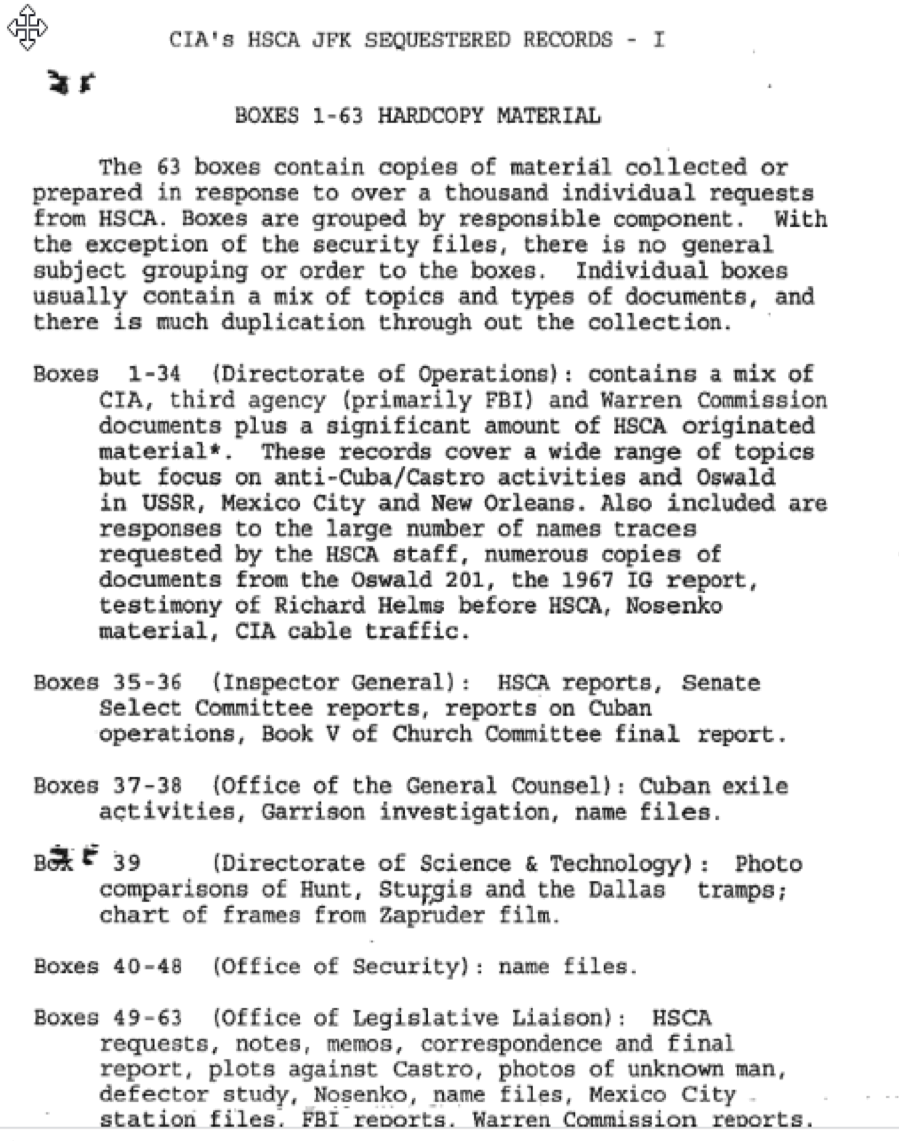
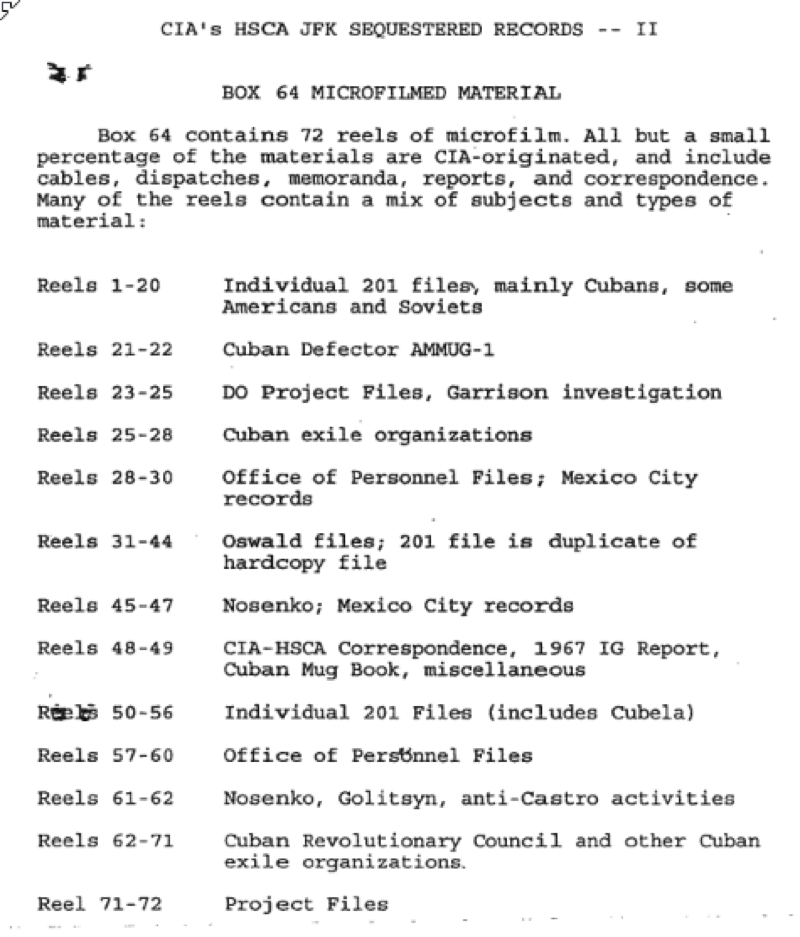
Relatively little has been done to connect the dots on the role organizations may have played wittingly or unwittingly in the coup.
We know that many organizations in Oswald’s orbit had links to intelligence including the Riley Coffee Company, the FPCC, Banister and Associates, Albert Schweitzer College, Alpha 66, the DRE, INCA, WSDU, and the Texas School Book Depository. Permindex and the International Trade Mart connect to both Clay Shaw and intelligence. Sullivan and Cromwell, United Fruit, Freeport Sulphur, and a number of other movers and shakers, as well as countless media organizations, were known to have hovered around U.S. security endeavors during the Dulles reign. They, of course, prefer that this dark history exclude their names, which was accomplished by the lone nut tale peddled by the Warren Commission. Knowing more about some of these interests would help us understand Oswald’s murky path that allowed puppeteers to “place him” strategically in the right spot at the right time to become a patsy.
For instance, it is impossible to imagine that the FPCC does not have a very thick file, given the surveillance programs of this outfit by both the FBI and CIA and its heavy infiltration by informants. Imagine if we could know more about who the informants were and their supervisors from the CIA and FBI.
Gary Hill in his book “the Other Oswald” explores the strange case of Robert Webster, who defected to Russia and returned to the U.S. at nearly the same times as Oswald. He shows how the Rand Development Corporation, Webster’s employer, is closely linked to intelligence, MKULTRA, and Webster’s saga.
In this article, he expands on his research on Rand and demonstrates just how much we could learn by understanding organizations Oswald and other of the main characters are linked to.
RAND Corporation
The RAND Corporation's the boon of the world,
They think all day long for a fee,
They sit and play games about going up in flames,
For Counters they use you and me.”[1]
In researching my book on Robert Webster[2], The Other Oswald, A Wilderness of Mirrors, I came to see that Webster’s employer, Rand Development Corporation, and his boss, Dr. Henry J. Rand, played important roles in determining Webster’s destiny. Their shadowy presence, always lurking behind the scenes, permeates his story. I decided to try to find out what this mysterious organization was about and why it was manipulating this easily influenced man.
Although Anthony Summers[3] labeled Rand Corporation as Rand Development’s parent company, I was unable to find any connection between the two companies.
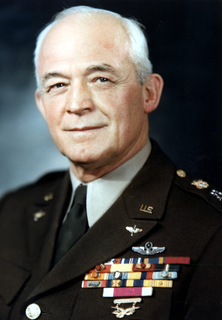
General H. H. “Hap” Arnold
Rand Corporation’s website describes its 1948 origins as follows:
As [WWII] drew to a close, it became clear that complete and permanent peace might not be assured. Forward-looking individuals in the War Department, the Office of Scientific Research and Development, and industry thus began to discuss the need for a private organization to connect military planning with research and development decisions.
Commanding General of the Army Air Force H. H. “Hap” Arnold articulated this need in a report to the Secretary of War:
“During this war, the Army, Army Air Forces, and the Navy have made unprecedented use of scientific and industrial resources. The conclusion is inescapable that we have not yet established the balance necessary to insure the continuance of teamwork among the military, other government agencies, industry, and the universities. Scientific planning must be years in advance of the actual research and development work.”
Other key players involved in the formation of this new organization were Major General Curtis LeMay; General Lauris Norstad, Assistant Chief of Air Staff, Plans; Edward Bowles of the Massachusetts Institute of Technology, consultant to the Secretary of War; Donald Douglas, president of the Douglas Aircraft Company; Arthur Raymond, chief engineer at Douglas; and Franklin Collbohm, Raymond’s assistant.
The name of the organization? Project RAND.
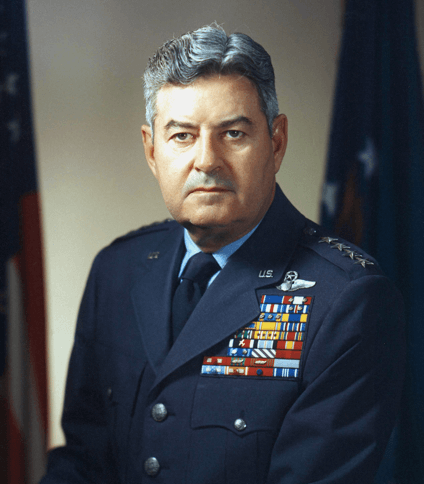
Curtis LeMay
Similar to the Russians’ “doomsday machine” in the satirical movie, Dr. Strangelove, RAND was to be a machine whose purpose was to fuel the fires of the cold war through research and development and inter-agency cooperation. The involvement of General Curtis LeMay[4] in such a project is no surprise. It was LeMay who was responsible for promoting RAND as his own project. It is apparent that the Air Force seems to have played a major role in the birth of RAND and oversaw its operations in the early years.
Wikipedia lists the birth of RAND Corporation as 1945, not 1948 as RAND’s website declares. However, its actual charter is dated March 1, 1946. Wiki says:
RAND was created after individuals in the War Department, the Office of Scientific Research and Development, and industry began to discuss the need for a private organization to connect operational research with research and development decisions. On 1 October 1945, Project RAND was set up under special contract to the Douglas Aircraft Company and began operations in December 1945.
Since the 1950s, RAND research has helped inform United States policy decisions on a wide variety of issues, including the space race, the U.S.-Soviet nuclear arms confrontation, the creation of the Great Society social welfare programs, the digital revolution, and national health care. Its most visible contribution may be the doctrine of nuclear deterrence by mutually assured destruction (MAD), developed under the guidance of then-Defense Secretary Robert McNamara and based upon their work with game theory. Chief strategist Herman Kahn also posited the idea of a "winnable" nuclear exchange in his 1960 book On Thermonuclear War. This led to Kahn being one of the models for the titular character of the film Dr. Strangelove, in which RAND is spoofed as the “BLAND Corporation.”
Pravda labeled RAND as the American “Academy of Science and Death.”
By its own definition, it is apparent that RAND’s purpose was to serve the Military Industrial Complex.
Rand Development Corporation
Rand Development is a more elusive entity. When I first saw that there was no mention of Rand Development in the history section of the RAND Corporation website, I thought that it was because of its involvement with the MKULTRA project. Or maybe because an employee, Robert Webster, defected while working on a Rand Development project in the Soviet Union. Or it could be because Rand Development went bankrupt in 1972 and no longer exists.
Whereas RAND Corporation’s name came from the initials of “Research ANd Development,” Rand Development got its name from its founder, James Henry Rand III also called H.J. Rand.
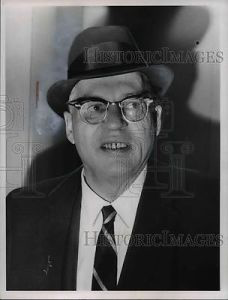
H. James Rand
Dr. James Rand III,[5] turns out to be an extremely fascinating entrepreneur.
James set up the Rand Development Company in 1950 with the primary aim to devise medical devices to benefit patients. He developed the first artificial larynx, which enabled an East Cleveland policeman to be reinstated in his job afterward.
By 1951, at age 38, Rand had 100 inventions to his credit. These included: the mechanical respirator, a tank respirator that replaced the bulky iron lung, an oxygen regulator for aircraft, a pulsating air mattress to eliminate bedsores, a plastic shoe sole, and a completely mechanized wheelchair that could be operated by mouth.
Rand also invented the Bendix automatic washer, the first Remington shaver, a non-leaking faucet valve, and a metal-impregnated cloth called Milium, used to line coats. He was also a co-inventor of a defibrillator and a respirator for chest surgery.
Rand Development prospered under James Rand. The company was even featured in a cover story in Business Week magazine in 1956.
James worked in the mid-1960s on a controversial cancer vaccine and began marketing it in 1966. In 1967, the federal government took his firm to U.S. District Court and won a ban due to not enough testing on animals first and manufacturing they determined was performed under unsanitary conditions. They banned the vaccine’s manufacture and use in the United States. The cancer vaccine never became available to the public. The trial was fraught with desperate cancer patients pleading for continued use of the vaccine.
In 1968, a federal grand jury indicted Rand Development on charges of stock manipulation and mail fraud. Those charges were later dropped in 1970, because they were based on the 1967 vaccine ban case that Rand had testified in and violated his right against self-incrimination.
An improved version of the vaccine was later tested in Mexico and showed some excellent results, as Rand said in a 1977 interview. The results of the tests had been published in Austria, but not accepted in this country.
Rand Development went bankrupt in 1972, and the assets, contents of labs, and offices were sold at auction.
According to his obituary,
James Henry Rand III was born on February 23, 1913, in Pelham, New York, to James Henry Jr. and Miriam Rand. He was a brilliant young boy for whom conventional schooling was inadequate. At age thirteen, Rand ran away from Peekskill Military Academy in New York, where he felt he would not learn anything new in science. He jumped a freight train and emerged from the boxcar in Cleveland, where he spent two weeks living at the Salvation Army before he was caught and returned to his family.
He returned to the military academy, which he completed in two years instead of the usual four. He spent a year in Europe, first at the University of Vienna and the University of Berlin. He enrolled at the University of Virginia at age 16 using two names: H. J. Rand and James H. Rand, to complete both his freshman year and his first year of Medical School.
James elected not to work at his father’s business, Remington Rand. While in his early twenties, he put together a chain of fifty-eight radio stations, that was later taken over by a larger company. His first invention was an instrument to mix the cabin atmosphere in the airplane with hydrogen, enabling pilots to get the correct mix of oxygen while flying. He sold this to the Bendix Corporation, who also hired him, where he worked out several inventions, including the automatic washing machine and the Remington electric shaver for Remington Rand, his father’s firm.
James Rand had a distinguished World War II record. He worked as a spy with the French underground until 1942, when he joined the Army Air Corps and the Office of Strategic Services. He worked in the White House map room until presidential aide Harry Hopkins discovered that he was the son of a prominent Republican and was banished.
He then became assistant chief of guided missiles, assigned to the guided missiles section in Sicily and Italy; he captured several enemy radar stations. Before the capitulation of Berlin, Rand, as a member of a secret mission, entered the city and brought out several German scientists to America.
As a lieutenant colonel in the U.S. Army, Rand flew the first plane to carry guided missiles in combat and received many decorations, including the Legion of Merit, the Bronze Star, ten battle stars in the European Theater, and the Merit Ribbon.
Rand was past president of the Cleveland Museum of Natural History and chairman of the 1949 heart campaign. Bethany College gave him an honorary doctorate and the Cleveland Jaycees named him 1949 Young Man of the Year. He founded the Cleveland Heart Society in 1953, as well as the National Inventors Council.
His wife Mary filed for separation in 1969, stating that her husband was guilty of gross neglect of duty. Rand had not paid her support money or given her funds to operate the home. He later married Martha Osborne.
James, who had diabetes since the age of 38 and also was using a heart pacemaker since 1974, died on November 6, 1978, of abdominal cancer, the disease he tried to conquer. He had used his cancer vaccine on himself.[6]
Rand and the Intelligence Community
Rand’s wartime connections to the Army Air Corps and the Office of Strategic Services explains his close links to the CIA and Air Force intelligence, ATIC, after the war. His OSS secret mission, rescuing German scientists from Berlin in 1945, links him to Operation Paperclip and Allen Dulles. Later, Rand Development Corporation became a CIA proprietary.
President, James “Henry” Rand, and top executive, George Bookbinder, had served together in the O.S.S., the forerunner of the CIA. Bookbinder worked under Frank Wisner[7] in Bucharest during the war.[8] He had close ties to the Rockefeller-owned Chase Manhattan.[9] Rand’s Washington representative Christopher Bird was a self-admitted agent of the Central Intelligence Agency.
The CIA ties to the Rand Development Corporation were exposed in 1968, when the Department of Interior conducted an expense inquiry into an anti-pollution contract between the Rand Development Corporation and that Agency. A Congressional Expense Inquiry showed that Rand Development held several CIA contracts. Doctor H.J. Rand was one of the first to undertake negotiations with the USSR for the purchase of technical devices and information on behalf of the Agency. An FBI Memorandum[10] tells of Sperry-Rand[11] developing an ink that “came out only under certain light.” The same document reveals that H.J. Rand received an $80,000 fee for the part he played in a law suit undertaken by the U.S. Department of Justice against the USSR. At this time, Rand Corporation was also conducting detailed studies of the Soviet economy in order to find out what proportion of the Russian GNP went into national defense.
It would seem to me that “invisible ink” might be used as a tool for spying. In fact, it’s hard to think of many other applications it would be useful for.
At the time of the U2 incident involving Francis Gary Powers, H.J. Rand had been trying to get the Russians to take out U.S. patents on several devices, including a sleep-inducing electric pulse generator he said would be very useful in surgery on patients whom anesthetic drugs are dangerous. Once the Russians took out the patents, Rand would buy the patents and market the Soviet products in the United States. However, the negotiations ended when Rand’s Russian offices were shut down in fallout of the U2 incident.
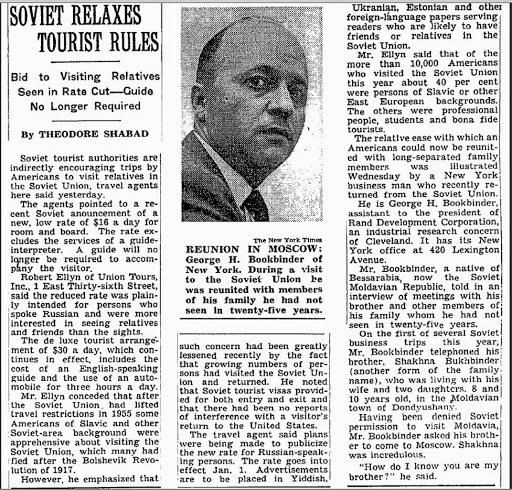
George H. Bookbinder, New York Times, November 15, 1959
Powers being shot down also foiled a plan to abduct Robert Webster—who had defected while working for Rand Development in 1959—and get him out of Russia in H.J. Rand’s car. Rand had left his car in the Soviet Union and planned one “last trip” to Moscow to bring the vehicle back. Accompanying Rand on the trip would be his usual sidekick, George Bookbinder, and also Dan Tyler Moore. Moore, whom Rand was reluctant to contact because of his erratic behavior and connections to journalist Drew Pearson, was his brother-in-law. Moore, formerly OSS, lived in Cleveland and was, at one time, affiliated with The Middle East Company. The branch office of the Middle East Company located in Turkey was referred to by the Soviets as a US Intelligence Operation. Rand described Moore as “a flamboyant type who is willing to try anything once or twice.” Rand’s hair-brained abduction scheme was never pulled off, due to the Powers incident that resulted in a tightening of security on all things American. The same document (the Grant-Gleichauf telecon) relating to Moore contains a provocative statement, “…the purpose of this notification is to provide some warning that an accident may be on its way to happen.” What accident? This document was dated May 4, 1960. Could the accident be the Powers downing? Were they anticipating this happening ahead of time? The event happened on May 1. This document is dated May 4, so it had already happened. However, as Bill Simpich believes, the key is the April 26 letter, that makes it clear they were planning to get Webster out of Russia over the weekend. It is credible that these words were spoken before May 1. In State Secret, Bill writes:
On April 26, Rand called the CIA Cleveland field office and told them that he and Bookbinder were heading to Moscow in the next ten days to try to get Webster out. On April 28, the CIA Miami chief got the word that Rand, Bookbinder, and their colleague Dan Tyler Moore were heading for Moscow. Like Rand and Bookbinder, Moore was ex-OSS. Moore was also the brother-in-law of Washington Post columnist Drew Pearson and had the savvy to put together a plan to smuggle Robert Webster into Rand’s car and out of the USSR. The Miami chief ended his message by saying that his note was ‘some warning that an accident may be on its way to happen.’ The plan was to smuggle Webster out on May 4.
Anthony Ulasewicz, a field officer of Nixon’s White House/Special Operations Group, described his first meeting with Nixon counsel and crime boss, Murray Chotiner: “When I first met Chotiner, the first thing he did was hand me a file on Rand Development Corporation and its officers.” Chotiner’s file on the Rand Development Corporation disclosed that, during the 1968 presidential campaign, Rand was named as a defendant in a lawsuit started by some angry Minnesota businessmen. The charge was that the Small Business Administration and the Government Services Administration were guilty of fraud and conspiracy in the way a government contract for some postal vehicles was awarded to a wholly-owned Rand Development Corporation subsidiary, the Universal Fiberglass Corporation. The Universal Fiberglass Corporation, the lawsuit charged, was born for the sole purpose of obtaining this contract. “Despite apparent lack of qualifications, a crony of Senator Hubert Humphrey awarded the contact to the Universal Fiberglass Corporation. The Universal Fiberglass Corporation defaulted and disappeared under Rand Development's umbrella.” Murray Chotiner was trying to bring this situation to the attention of the media.[12]
But the CIA was not the only intelligence agency connected to Rand Development. Air Force Intelligence, ATIC, also worked closely with them in projects dealing with the Soviet Union.
An FBI memo states, “In as much as James H. Rand, President of the Rand Development Corporation, Cleveland, OH, is cooperating with the U.S. Air Force in obtaining information from the Soviets, it is possible that Rand has already furnished information to the Air Force bearing on this matter.”[13]
H.J. Rand’s father was Vice President (chairman) on the board of Sperry-RAND, which also worked closely with the United States Air Force. Sperry-RAND had initially funded the Rand Development Corporation. James Rand III was a twin son of Remington-Rand founder James Henry Rand Jr. who turned over the operation of Remington Rand in 1958 (which had previously merged with Sperry Corp), to James’s twin brother Marcell. Vice-president of research and development for Remington-Rand in those years (1948–1961) was the former chief of the Manhattan Project, General Leslie R. Groves. Among other sundry defense contracts, Remington-Rand was collaborating with Bell Labs on nuclear missile guidance systems.
Internal memos from the CIA requested by the HSCA investigation note that Rand and Bookbinder had traveled previously in 1958 to the USSR with “Brigadier General” W. Randolph Lovelace, an eminent physician with Atomic Energy Commission contracts who co-founded the Lovelace Clinic in Albuquerque New Mexico. One memo reads: “For your information, only Rand, Bookbinder, and Lovelace have had frequent contact with Soviet officials both in the United States and the USSR, including Mikhail Ilich Bruk, formerly with the Soviet Ministry of Health, who was identified by AEDONER [Yuri Nosenko] as an agent of the KGB.”
When Robert Webster defected in 1959, he did so as an employee of Rand Development at a Moscow Trade Exhibition. On October 17, 1959, Webster was living in Moscow. He attended a meeting at the central office, visas and registration (OVIR); with the original Soviet representative he had contact with, an unknown Soviet, H.J. Rand, his assistant George H. Bookbinder, as well as Richard E. Snyder of the U.S. Embassy. Webster stated he was free to speak and told Snyder when he had applied for Soviet citizenship that he had been granted a Soviet passport on September 21, 1959. He filled out a form entitled “Affidavit for Expatriated Person” and wrote his resignation to Rand Development Corp.
While it is possible that Webster may have been a witting asset in a false defection stratagem, his pre- and post-Russia odyssey behavior and treatment lead me to believe that, unlike Oswald, he was a genuine, albeit confused defector, who went to Russia, not for ideological reasons, but mostly to escape a complicated personal life at home. We may never know for sure.
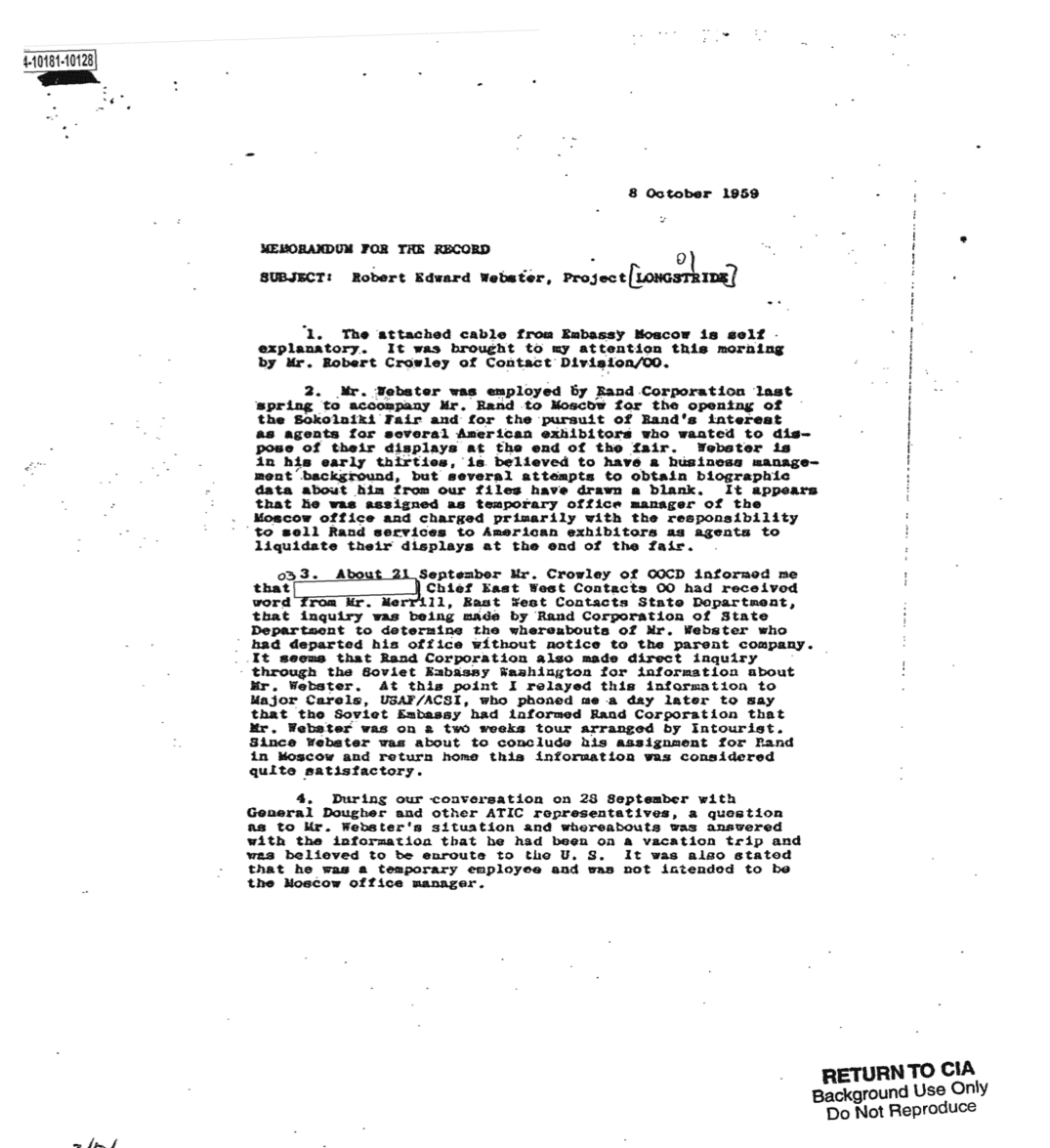
My research further revealed that Webster was part of an ATIC project called LONGSTRIDE. Internal CIA memos revealed that Webster was known as “Guide 223” and fellow Rand Development employee Ted Korycki was known as “Lincoln Leeds.” The fact that the CIA approached ATIC at the Moscow Fair, rather than Rand Development itself, indicates inter-agency cooperation.
Rand’s liaison with ATIC was Major Joseph Carels. In light of the recent revelation of Webster's role in Project LONGSTRIDE, it appears that Carels was lying when he advised that Air Force Intelligence Headquarters had no information regarding Webster. As a result of a teletype inquiry by Carels to Air Technical Intelligence Center (ATIC), Wright-Patterson Air Force Base, Ohio, (this organization handles covert projects of AF), Carels was advised that the subject was an employee of Rand Development who could not be located and thus was reported as missing. The message stated that the subject has taken a 20-day in-tourist tour to Kiev. “Subject (Webster) is a technician and is not witting or involved in ATIC[14] activities.”[15] Rand Development Corporation’s connection to the U.S. Air Force at the Moscow Fair may have been unknown to Webster, however it is likely that Webster’s movements were likely being choreographed by Air Force intelligence, whether he knew it or not.
Dr. Rand was obviously a source for ATIC as is indicated by an AIRTEL TO BUREAU NY 105-37687 stating: “Inasmuch as James H. Rand, President of Rand Development Corporation, Cleveland, Ohio, is cooperating with the Air Force in obtaining information from the Soviets it is possible that Rand has already furnished information to the Air Force bearing on this matter.”
Another FBI memorandum states; “Rand cooperates with Air Force Intelligence on technical intelligence projects.”[16]
An area that needs more research is that involving the connections of Sylvia Hyde Hoke, the sister of Ruth Paine. Sylvia, a psychologist, was employed by the Air Force as a “Personnel Research Technician.”[17] It was the Personnel Research branch of the Air Force that implemented Project LONGSTRIDE, of which Webster was involved. Hoke was also employed by the CIA since at least 1961. Perhaps it is just a coincidence that the two Hyde sisters are somehow linked with the two defectors, Oswald and Webster. The same two that James Angleton was dangling to the Soviets in his mole hunts?
There also seem to be connections between the elusive triad of espionage entities (CIA, ATIC and Rand Development) and experiments in behavior and mind control.
The CIA’s MKULTRA projects are well known. But what is known of the role of Rand Development and ATIC’s in this murky misadventure of controlling human minds?
Rand Development’s Washington representative, Christopher Bird, served as ‘Biocommunications Editor/ Russian Translator’ for Mankind Research Unlimited, Inc., a Washington think-tank specializing in parapsychology and other behavioral sciences. Dick Russell reports that “MRU’s Company Capabilities list included brain and mind control…acquiring on a daily basis, a large amount of unique bio-cybernetics data from Eastern Europe.”[18]
According to CIA psychiatrist, Dr. Louis Jolyon (Jolly) West,[19] ATIC and Rand Development worked closely together in behavior modification research. He claimed that Air Force Intelligence, like the CIA, was also involved in mind control research projects. West himself, although he initially denied it, was conducting LSD research under the MKULTRA banner.
It is now clear that the H.J. Rand Foundation was a part of MKULTRA SUB-PROJECT NO. 79. The document below lists Rand as a “cut-out” for the purpose of funding organizations engaged in very “sensitive” research. The document is dated 1957–1962, the very time in which Robert Webster was employed by Rand. It encompasses his defection and return from Russia (59–62). Also, this is the same time period of Oswald’s Soviet odyssey. It also states that “all” of the Rand Development's participants were witting of the agency (CIA) relationship. That would include plastic’s expert Robert E. Webster. Note that this document is approved by C.V.S. Roosevelt.
Roosevelt, grandson of Theodore, who served as the chairman of the Technical Surveillance Countermeasures Committee, which involved securing American facilities against electronic eavesdropping. Richard Bissell’s testimony during the Church Commission, as well as CIA source documents, connect Roosevelt directly to plans to poison Castro. Roosevelt, as a head of the CIA technical division, was Sidney Gottlieb’s supervisor. According to Roosevelt, his work for the CIA mainly involved creating devices to detect listening devices. He also mentioned that he took part as a subject in the CIA experiments on LSD as part of MKULTRA. Retiring from the CIA in 1973, he served in retirement as a defense consultant and on the board of Aerospace Corporation.
Further evidence of Rand Development’s involvement in MKULTRA is their 1958 study revealing that, “a defensive use for hypnosis was a more practical use than the previously sought offensive goal of a Manchurian Candidate.”
NARA Record Number: 157-10014-10093
TESTIMONY OF RICHARD BISSELL, 10 SEP 1975
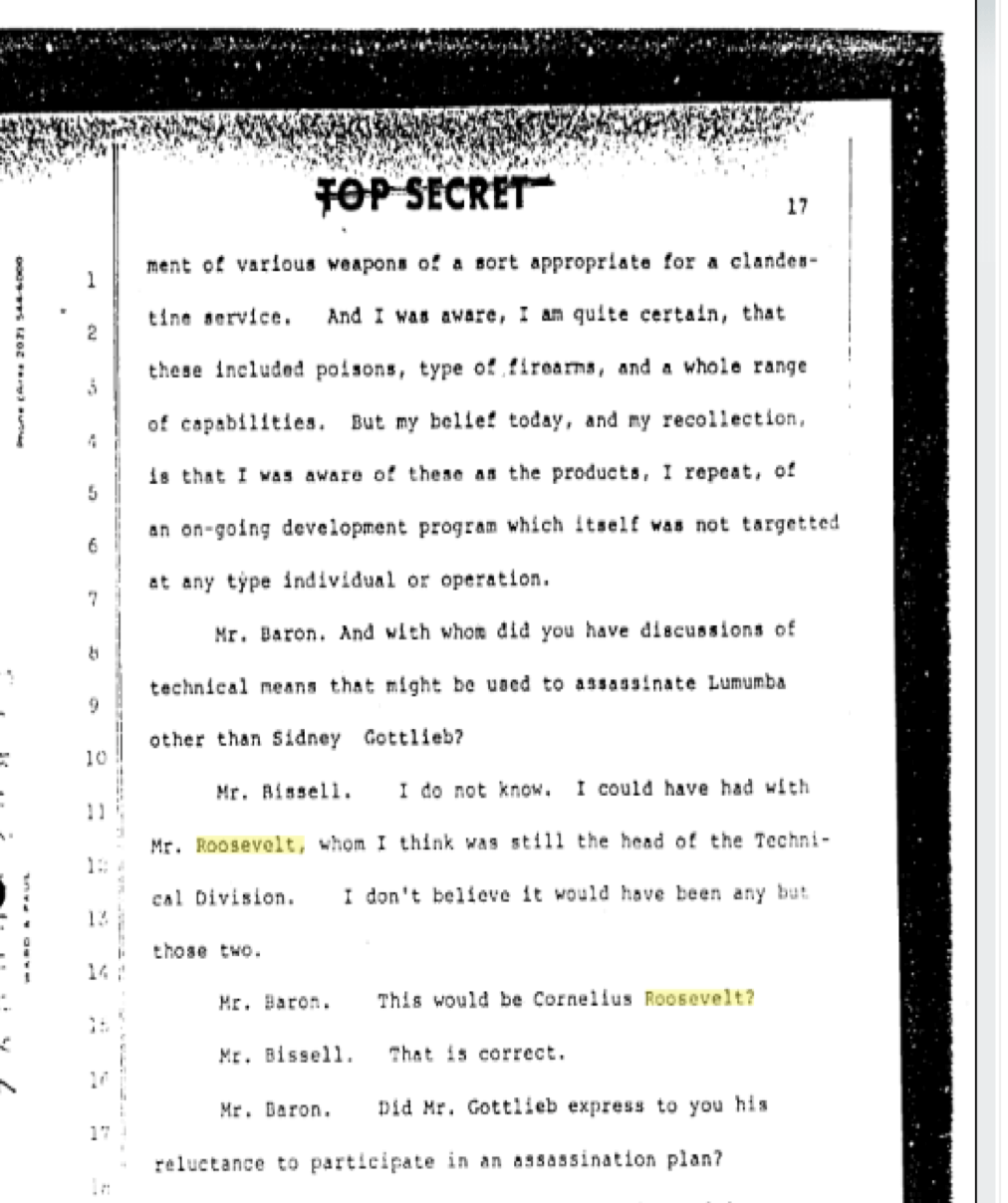
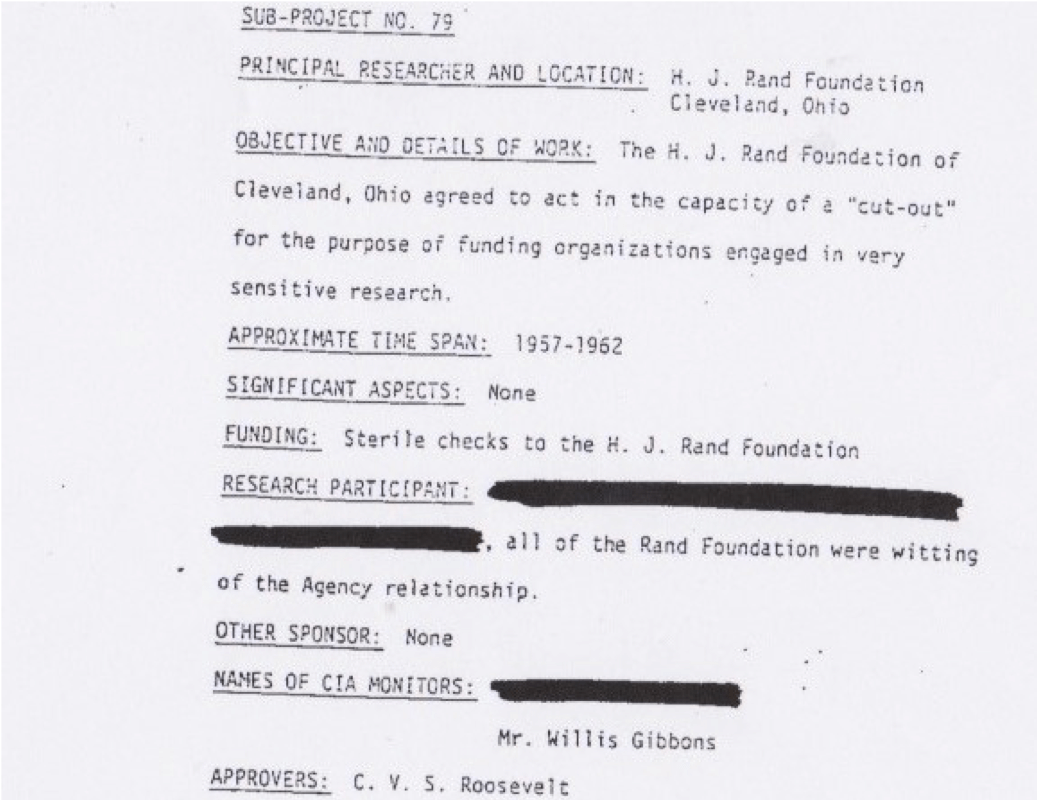
RAND Corporation was the CIA think-tank where Daniel Ellsberg copied the Pentagon Papers. According to the New York City phone directory, Rand Corporation and Rand Development were located on opposite sides of Lexington Avenue in New York City. However, this seems to have been a deception.
Researchers Alan J. Weberman and Michael Canfield visited the address of Rand Development Corporation listed in the NYC phone directory. The building registry had no listing for Rand Development Corporation. The doorman told them that he had worked there for 33 years and there had never been a Rand Development Corporation in the building. He suggested they go to Rand Corporation across the street at 405 Lexington Ave. From what I could find, RAND’s NYC office was part of a HUD study group for LBJ's Great Society described as an Urban Institute.
Another odd coincidence involving the Air Force is that four of Oswald’s fellow employees at Reily Coffee went on to employment with NASA. Oswald himself cryptically hinted that working there might be in his future. He told Adrian Alba, proprietor of the Crescent City Garage next door to the Reily Coffee Co. in New Orleans, that he had “found his pot at the end of the rainbow,” and that he expected to get a job at NASA in New Orleans. As stated, four of Oswald’s coworkers at Reily did get jobs at NASA in New Orleans within weeks of his departure.[20] However, by the time he had returned to Dallas, in the fall of 1963, he was telling his landlady, Mary Bledsoe, that he would soon be working for Collins Radio, a CIA front company deeply involved in the military industrial complex.[21]
In fact, it is obvious that Oswald had ties or links to an array of CIA/Military Industrial Complex friendly companies; Collins Radio, NASA, Reily Coffee, Guy Banister Associates, Jaggars-Chiles-Stovall, and perhaps the TSBD.[22] In addition, he wrote or belonged to organizations being investigated by the FBI and CIA; the FPCC, the American Civil Liberties Union, C.O.R.E., and the American Communist Party. In addition, Oswald was as an underage worker with the Gerald F. Tujague Inc., a freight broker on the New Orleans water front. Tujague was a friend of Guy Banister. In addition, Tujague was Vice President of the Friends of a Democratic Cuba. The purpose of the FDC was to raise funds for the CIA-backed Frente Revolucionario Democratica (FRD-Cuban Democratic Revolutionary Front.) Tujague told FBI agents that Oswald was in regular contact with the U.S. Customs Export Office, yet another government agency.
Summary
In essence, RAND Corporation rose out of the ashes of WWII. The Manhattan Project had shown that pooling the best minds; scientists, physicists, mathematicians, and technicians had resulted in a huge leap forward in weapons development. The prospect of these great thinkers going back to work in the private sector was anathema to Hap Arnold, the only five-star general in the Air Force. He and Franklin R. Collbohm became the fathers of the RAND PROJECT. But it was General Curtis LeMay who took the project by the horns and became its godfather. Subsidized and more or less subservient to the Air Force, the project arose out of the Air Force’s interest in developing intercontinental ballistic missiles. In addition to General Arnold, key players involved in the formation of Project RAND were: Edward Bowles of M.I.T., a consultant to the Secretary of War; General Lauris Norstad, then Assistant Chief of Air Staff, Plans; Major General Curtis LeMay; Donald Douglas, President of Douglas Aircraft Company; Arthur Raymond, Chief Engineer at Douglas; Franklin Collbohm, Raymond's assistant.
The RAND (Research And Development) Corporation of Santa Monica, California, began as a United States Air Force Project in 1945 under contract to the Douglas Aircraft Company. Its broadly defined function was to study American national security and, in particular, the role of airpower in that context. Three years later, the Ford Foundation endowed RAND as a private, nonprofit research corporation “to further and promote scientific, educational and charitable purposes” to the nation's general benefit. As one of the first American “think tanks,” however, its staff focused primarily on military and strategic issues funded by the U.S. government. For the first two years of its existence, RAND allocated the lion’s share of its Air Force research funds for applied science projects to subcontractors like Bell Telephone, Boeing Aircraft, and Collins Radio Company.[23] Other RANDites who would later play a role in American politics include: Condeleezza Rice, Dr. Luis Alvarez, and Donald H. Rumsfeld, who at one time was Chairman of their Board of Trustees.
Rand Development was a separate entity used primarily by the CIA, but also working closely with Air Force Intelligence (ATIC). The areas of the corporation’s usefulness included information related to the Soviet economy and military budget; negotiations with the USSR for the purchase of technical devices and information on behalf of the CIA; cooperation with Air-Force Intelligence on technical intelligence projects such as LONGSTRIDE; and acting as a CIA “cut-out” in an MKULTA sub-project defined as funding of organizations involved in very sensitive research. This research included mind and behavior control, a subject of interest to both the CIA and ATIC. In return, Rand received financial rewards through favoritism in the securing of government contracts, as well as a monopoly in being allowed negotiations involving Soviet technology.
My research on Robert Webster led me to believe that H.J. Rand was not only his boss, but his close friend and mentor. Their relationship was very similar to that of Oswald and George de Mohrenschildt. I doubt if we will ever know whether James Rand played any role in encouraging Webster to defect or connecting him, knowingly or unknowingly, with an ATIC project (LONGSTRIDE). But it seems odd that Webster, a man with no connections to the Air Force (an ex-navy man), was involved in this Air Force Intelligence project while in the Soviet Union. In addition, he became a Soviet citizen. Think about it. A defector who gave up his U.S. citizenship to become a Soviet citizen is now part of a U.S. intelligence project? If he was aware of this he could be defined as an American spy or at the very least some kind of dangle.
Bibliography
Conspiracy, Anthony Summers, McGraw-Hill Book Co., 1980.
Soldiers of Reason, Alex Abella, Mariner Books, 2008.
The Man Who Knew Too Much, Dick Russell, Carroll & Graf Publishers, 1992.
The Other Oswald, A Wilderness of Mirrors, Gary Hill, TrineDay, 2020.
[1] The Rand Hymn, by Malvina Reynolds
[2] “The Other Oswald, A Wilderness of Mirrors,” Gary Hill, TrineDay 2020. www.theotheroswald.com
[3] Summers says: “Rand Development Corporation was formed by the Rand Family. The name ‘Rand Corporation’ is a title made from the contraction of the words ‘Research and Development.’” It seems he may have linked the two unintentionally by inference of name. Also, Dick Russell, in his book The Man Who Knew Too Much, said: “Like its parent, Rand Corporation, it (Rand Development) also held several CIA contracts.” The footnote for this statement reads: Rand Development ties; WCE915, WC XVIII, HI 13; Summers Conspiracy pp 177–178. But the WCE915 document says nothing about Rand. It is a letter from Richard Snyder to the State Department about citizenship of defectors.
[4] It was LeMay that was responsible for the firebombing of Tokyo in WWII that resulted in the deaths of 100,000 civilians. These were mostly women, children and old men. It was also he that proposed a first strike on the Soviet Union during the Kennedy administration. His take was that we would only lose 30 or 40 million Americans. That, he felt, was an acceptable sacrifice. In his book, The Fog of War, he was quoted as saying, “If we had lost the war, we’d all have been prosecuted as war criminals.”
[5] Also known as H.J. Rand.
[6] https://bratenahlhistorical.org/index.php/james-rand/
[7] In the OSS Wisner was transferred to Germany where he served as Liaison to the Gehlen Organization. Later, in the CIA, he ran the Office of Special Projects (OSP), which later became the Office of Policy Coordination (OPC). J. Edgar Hoover called the OPC “Wisner’s Weirdos.”
[8] NYT 6.15.59; Smith OSS Univ. of Calif. Press London 1977, p. 397.
[9] State Secret, Chapter One, Bill Simpich.
[10] See this document in appendix C of “The Other Oswald, A Wilderness of Mirrors, Gary Hill, TrineDay, 2020. www.theotheroswald.com
[11] Rand III’s father (James Rand Jr.) founded American Kardex, an office equipment and office supplies firm which later merged with his father's (James Rand Sr.) company, the Rand Ledger Corporation. Rand later bought out and merged with several other companies, notably the Remington Typewriter Company, to form Remington Rand. In 1955, Rand merged his corporation with the Sperry Corporation to form Sperry-Rand, one of the earliest and largest computer manufacturing companies in the United States.
[12] Ulasewicz, Pres. Priv. Eye, 1990.
[13] 124-10210-10354
[14] ATIC later evolved into NASIC.
[15] Memorandum from P.H. Fields to F. A. Frohbose 105-81285-3.
[16] 124-10210-10354
[17] NARA Record Number: 1993.07.24.08:39:37:560310-FB1105-1261128-7,12/12/63; also, CIA memo dated 7/30/71 claims Hoke a CIA employee since 1961.
[18] Ibid from A.J. Weberman "Mind Control: The Story of Mankind Research Unlimited, Inc." CovertAction (June 1980), p. 17.
[19] “Jolly” was appointed by the court in his capacity as a brainwashing expert in the Patty Hearst trial and worked without a fee. Believing that Hearst displayed all the classic signs of coercion and brainwashing, after the trial, he wrote a newspaper article asking President Carter to release Hearst from prison. West also visited Jack Ruby several times in his jail cell along with Dr. Robert Stubblefield, who was also involved in the MKULTRA program. What went on in that cell, no one knows. But Ruby was suddenly found insane.
[20] In Deadly Secrets, Warren Hinckle and William Turner write, “Oswald told Adrian Alba, the owner of the garage next door to where he was working, that his application was about to be accepted ‘out there where the gold is’—the NASA Saturn missile plant in suburban Gentilly. NASA of course didn’t employ security risks. But tucked into its Gentilly facility was an active CIA station that provided a Kelly Girl service for operatives in between assignments” (p. 239). The endnote reads, “The CIA’s practice of providing interim employment for its agents and assets is well known,” The passage in Turner repeats the familiar statement from Adrian Alba, then adds, ”On the face of it, the idea that [the Marxist] Oswald could get a job at a space agency installation requiring security clearance seems preposterous…But [Jim] Garrison pointed out that it is an open secret that the CIA uses the NASA facility as a cover for clandestine operations.”
[21] Bledsoe on Oswald’s activities: 6 WCH 404 and Oswald on Collins Radio WCE-1985.
[22] Another possible link he made was his travel arrangements on the first leg of his trip to Russia through “Travel Consultants,” a New Orleans based travel agency also used by Clay Shaw. On the agency’s questionnaire he gave his occupation as “shipping export agent.”
[23] See chapter 12—“The Other Oswald, A Wilderness of Mirrors,” Gary Hill, TrineDay 2020, for Collins links to the JFK Assassination.


